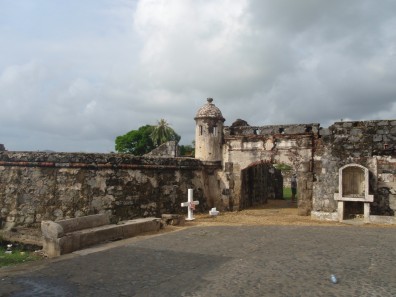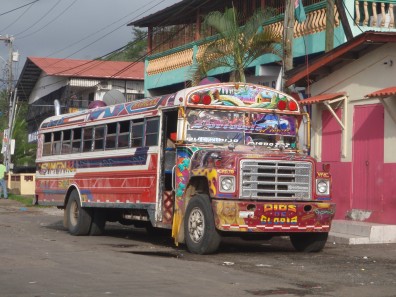COSTA ARRIBA

Costa Arriba means ‘upper coast’. This is the stretch of coast that stretches from Punta San Blas in the east to Colon – and the entrance to the Panama Canal – in the west. It is about sixty miles long.
The historical significance of this stretch of coast dates back to the Spanish colonization. Silver and gold extracted from South America was hauled over land across the isthmus, and it was loaded on ships in various ports along this coast – particularly Portobello. Riches brought piracy, and this was a very lively area.
In later years, this area was populated by many of Antillean descent, and the Jamaican influence persists. This is where the ‘congo culture’ originated.
We planned only two stops along this coast. It is getting late in the season, and we hope to get through the Panama Canal before the rains begin. So we are trying to keep moving until we are through the canal.
There was a low tide when we left Isla Porvenir, so we chose not to go through the coral infested shallows to get back out in to the Caribbean Sea. Instead, we went a few miles further to get back in to deep water more quickly.
We put up our full main (first time since ?) and full #2 jib, and we had a very nice broad reach. We had a nice sail all the way to Playa Chiquita where we had planned to anchor. But the anchorage was not good. It was small, shallow, and rolly. And it was surrounded by a lot of shallow reef. We had little protection from the swells rolling in.
We quickly decided to move on to a more secure anchorage, but where? It was already 3:00 PM local time, so we had only a few hours of daylight left. We decided that we could make it to Isla Grande if we pushed it. And we did.

We had up our full main, full #2, and staysail. And we ran the engine at 1500 RPM. We made it in shortly before dark.
Isla Grande is a popular playground for those in Panama City. It has hotels, restaurants, and some shops. But we did not get to see any of that. We dropped the hook, had a light dinner, slept, and left the following morning.

When the rains stopped, we took the dinghy for a harbor cruise. From the dinghy, we had a great view of the old fortification at the head of the bay.
We went ashore, and we visited the old customs house which was originally built in 1630 and restored as needed through the years. We visited San Jeronimo Fort Battery, built in 1760, with two levels supporting twenty cannons. And we visited the Church of San Felipe de Portobello. This church was built in 1814. It houses a wooden statue of a black Jesus that is credited with numerous miracles and has an enthusiastic following. The festival of the Black Christ of Portobello is celebrated every October 21.
We bought a few things at the local grocery and returned to the boat. The jungle comes down to the water in the bay, and the howler monkeys entertained us for the rest of the evening.
But we were anxious to head toward the canal and start the transit process. We left Portobello the following morning.
Return to our Panama page
Follow us to the Panama Canal
or to Las Perlas Islands

Colorful Panama buses